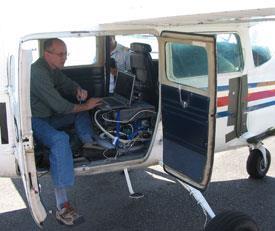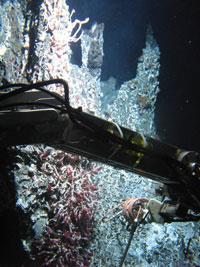It takes a mix of ingenuity and engineering expertise to develop mass spectrometers for use in extreme environments. Emma Davies investigates
It takes a mix of ingenuity and engineering expertise to develop mass spectrometers for use in extreme environments. Emma Davies investigates
For Nasa, a leak of the cryogenic propellants hydrogen and oxygen during a space launch could spell an explosive disaster. During routine leak checks the engines are filled with helium, and mass spectrometers used to scan for any traces of escaping gas. For scientists studying volcanoes, increases in helium emissions can also forecast a catastrophic event. So it makes perfect sense for Nasa scientists to collaborate on a mass spectrometry project with Costa Rican researchers measuring gas releases from the craters of active volcanoes.

These days it’s not unusual to find mass spectrometers being used in extreme environments. As the instruments become ever more portable and robust they are being taken to more inhospitable environments on Earth and in space. Those working in ’harsh environments’ tend to adapt and build spectrometers themselves so there is much interest in the work of other scientists facing similar challenges.
Helium high
When Tim Griffin, chief of the polymer and chemical analysis branch at Nasa’s Kennedy Space Center in Florida, US, got talking to a volcano expert from the University of Costa Rica at a conference, it soon became clear that a collaboration would be mutually beneficial. Nasa would make technological advances while the University of Costa Rica would get closer to its long-term goal of setting up small autonomous mass spectrometers to monitor volcanic activity. Griffin’s Nasa team has now had two research stints in Costa Rica and currently has proposals for further work.
Helium forms beneath the Earth’s surface as a by-product of radioactive decay from heavier elements, and is physically trapped there until volcanic activity releases it. Even modest increases in helium emissions indicate that new fissures are forming in the Earth’s crust and can forewarn of an impending eruption.

Mass spectrometry is the only analytical technique capable of monitoring helium concentrations in situ in real time and can give a good idea of what is happening deep within a volcano.
Griffin’s team at the Kennedy Space Center has developed a portable mass spectrometer (a linear quadrupole) which can be taken to about 13km above sea level. ’This is a commercial off-the-shelf unit but we built our own sample delivery system and our own sample chamber. We also did all the control electronics and software in house,’ recalls Griffin. While in Costa Rica, he took one of the spectrometers in a Cessna aeroplane (see left) and flew through volcanic plumes above all the major volcanoes, measuring concentrations of helium, water, CO2 and sulfur dioxide (some of the most abundant gases released by volcanoes). Researchers also drove the system around the city of San Jos? in a 4x4 vehicle and carried it on foot to the craters of the country’s Turrialba and Miravalles volcanoes.
The Nasa team has a long history of looking for the kinds of gases emitted by volcanoes but the Costa Rican project landed them with a series of tough experimental and logistical challenges.
’The temperature - other than it being so hot that it will melt your sample tube - didn’t really prove to be too much of an issue,’ says Griffin. The biggest problem was dealing with the high level of steam in the volcanic environment, which would swamp the mass spectrometer. ’Water is a big issue everywhere,’ he explains. Nasa normally purges areas to remove moisture before taking samples but this obviously couldn’t be done at the volcanoes and so the Nasa team came up with a new sample delivery method. ’We learnt a lot about the instrumentation and came up with ideas that we are looking to incorporate into our new systems here [at the Kennedy Space Center],’ says Griffin.
Getting all of the equipment and spares through customs proved one of the biggest challenges for the Nasa team. ’Trying to plan for any contingency is a tough thing,’ Griffin says. ’It’s a small instrument but we took a lot of equipment with us.’
Space spectrometers
Spares are not an option for Hunter Waite, a space physicist at the Southwest Research Institute in San Antonio, Texas, US, who leads the ion and neutral mass spectrometer team for the Cassini space mission, a collaboration between Nasa, the European Space Agency, and the Italian Space Agency. His team had to build a quadrupole mass spectrometer robust enough to operate unmanned for years in space during Cassini’s tour of duty around Saturn.
’We design and build these things to last a long time. We have redundant filaments for the electron ionisation source and a very robust instrument,’ says Waite. ’A really good quadrupole mass spectrometer in the lab might cost you about $75,000 (?50,400). This cost over $20 million. You build it in a completely different way. You design every bit to be robust and you’re very careful about part selection.’

The Cassini orbiter entered the Saturn system in 2004 and has since flown by Titan (its largest moon) about 60 times and by the small, icy Enceladus (Saturn’s sixth largest moon) several times. ’Each time we go by we get a different set of measurements from a different position,’ says Waite.
The mission has already made huge, widely reported discoveries on Titan including vast methane lakes, rocky shores, and wide expanses of hydrocarbon sand dunes. Meanwhile, a plume of ice particles was discovered shooting from Enceladus. Cassini completed its initial four-year mission in 2008 and is now on the Cassini Equinox mission, looking for signs of seasonal climate changes in the Saturn system.
The atmosphere on Titan is mainly composed of nitrogen. There’s also methane and hydrogen from dissociation of the methane, then a whole host of organic compounds. ’We see things as complex as benzene,’ says Waite. ’There’s a very, very rich organic mixture that contains just about every hydrocarbon that you can imagine plus most of the nitriles that you can imagine. This complexity goes all the way through the mass range of our mass spectrometer. And it doesn’t stop there, it keeps going.’ Waite knows of the existence of compounds with a molecular weight of over 5000Da. ’We can confirm their presence with other instrumentation but we can’t measure the composition with the mass spectrometer because we don’t have the mass range. If we go back we’ll build a mass spectrometer that has better resolution and a larger mass range,’ he says.
His team is working on instrument improvements and can now get 50 000 mass resolution quite easily with time of flight mass spectrometry, far exceeding the 100 mass resolution with Cassini’s spectrometer.
Before they revisit Titan, Griffin wants to do some Earth-based ocean studies in preparation for possible future exploration of Kraken Mare, a 400 000km2 hydrocarbon lake in Titan’s northern hemisphere. ’Going to the oceans and testing some of this mass spectrometry is a good start so that we can develop membranes that might be applicable for the inlet system to allow the gas to permeate through a membrane from liquid,’ says Waite. ’It’s a technique that has been used in the oceans quite a bit,’ he adds.
Biomass in the basin

Peter Girguis, an expert in deep sea organisms at Harvard University, Cambridge, US, might be just the man to help. He uses mass spectrometry to study the metabolic rates of microbes thousands of metres under the sea and has developed a system for open data sharing. His next research expedition is to the North Pond Basin, a valley in the underwater mountain range the Mid-Atlantic Ridge. He sees the project as a unique opportunity for a group of investigators to develop technologies that are appropriate for remote observatories. ’Whether it’s the sea floor or a mountain top or a hot spring or Europa [one of Jupiter’s moons], the core technologies are pretty similar,’ he says.
Recent studies have pointed to a thriving microbial community in marine sediments in the parts of the Earth’s crust that come to the surface in the basins created by mid-ocean ridges (the oceanic crust). Since about 80 per cent of the biosphere is deep ocean - below 1000m in depth - the biomass of deep sea microbes may well exceed the total biomass on all the continents, Girguis suggests.
His mass spectrometers will next be in active service in hydrothermal vents in the sea floor in the North Pond Basin. The entire volume of the Atlantic Ocean could circulate through the basin every 5000 to 10 000 years, says Girguis. So the microbes could have a direct influence on ocean chemistry. ’The North Pond site is unique in respect to the distribution of oxygen in the sediments,’ he adds. ’Sediments in general are anaerobic. For reasons that we don’t fully understand there seems to be quite a lot of oxygen flowing around these sediments. It’s interesting in terms of the geochemistry and that makes it interesting in terms of the microbes it can support.’
This summer, the International Integrated Ocean Drilling Program will send its high-tech drill ship, the JOIDES (Joint Oceanographic Institutions for Deep Earth Sampling) Resolution, to drill the bore holes that Girguis needs for his research. Next year, he and his team will go out to set up the instruments. Then it’s a question of finger crossing and patience as they wait a full year before they can return to collect the data.
Spectrometer story

Girguis has been working on mass spectrometers since his PhD days. He started developing an underwater mass spectrometer while doing a postdoc at the Monterey Bay Aquarium Research Institute (MBARI), US, taking advantage of advances in the semiconductor world. ’We had to engineer an inlet system that would allow us to de-gas water at full ocean pressure and allow those gases to enter a high vacuum,’ recalls Girguis. Working with John Erickson, an MBARI engineer, Girguis designed an inlet system where the pressure on the membrane inlet is distributed to a honeycomb-like titanium support structure behind it, allowing gases to pass through.
The hydrothermal vents where the mass spectrometer needs to operate are harsh environments. During Girguis’ last experiment in the field he took a mass spectrometer to look at dissolved gases in water coming out of hydrothermal vents in the sea floor at 300?C. Because of the pressure, the water doesn’t boil, but it is still hot and acidic enough to scorch a wooden broom handle, says Girguis. His team designed a titanium inlet system that takes the water and cools it down before delivering it to the mass spectrometer.
For the North Pond project, the researchers will insert a ’string’ (a pipe) into the drill hole. This will contain instruments including oxygen sensors cleverly designed in house not to consume oxygen. The mass spectrometer is encased in a titanium bottle (about 1m long and 0.2m diameter) and will sit atop the hole. A pipe system will bring fluid up to the mass spectrometer from different depths. The mass spectrometer will be programmed to turn on once every hour, take a sample and analyse it before ’deciding’ whether to take another sample or turn itself off, explains Girguis.
’Our mass spectrometer gives us the opportunity to go down and measure the dissolved volatiles, from oxygen and hydrogen to hydrogen sulfide, methane and other alkanes,’ he says. ’The thing I’m most proud of is that it is made to be an open-source instrument. I’m hoping that we can foster the widespread use of these instruments and other instruments of oceanography.’
Mini MS
Tim Short, who runs the chemical sensors group of the marine technology program for US not-for-profit research company SRI International, could perhaps benefit from the open-source approach. He has worked on many underwater mass spectrometry projects, including developing ways to monitor pollutants in harbour water.
One of his projects is with the Gulf of Mexico Hydrates Research Consortium, which monitors methane hydrates on the sea floor (a potential energy source but also a huge greenhouse gas source). ’We’re trying to get information about why these hydrates are so stable and why they become unstable,’ says Short.
Power supply to the mass spectrometer limits the duration of experiments in the field and Short’s team is looking to reduce power consumption. One way to do this is by making smaller mass spectrometers. Short hopes one day to make a mass spectrometer the size of a mobile phone but admits that such a device is some way off.
When you reduce the size of a mass spectrometer you typically lose mass resolution or sensitivity, explains Short. But by linking together a series of identical ion traps, he and his team hope to retain sensitivity. ’We have demonstrated that we can get decent mass spectra out of single little traps. Now we’re starting to work on making large arrays of those traps,’ he says.
Mass challenge
Ben Langford, a postdoc at Lancaster University, UK, could have done with a miniature mass spectrometer during fieldwork in the jungle in Malaysian Borneo as part of the OP3 (Oxidant and Particle Photochemical Processes) project (see Chemistry World, March 2009, p40). It took large numbers of people to haul three large mass spectrometers through the jungle and to put one up a tower and one on a platform high in the tree canopy. ’We made meticulous plans based on previous experience - any component part that had broken in the past we made sure we had spares of,’ recalls Langford. ’Within 30 minutes of switching the instruments on all three had broken with the same fault - a fault we had never seen before.’
’When you take a mass spectrometer out into the field anything can happen and it normally does,’ says Langford. Taking mass spectrometers into harsh environments certainly requires forward planning, a cool head and a sense of adventure. There is much that disparate groups working in harsh environments can learn from each other. ’I personally think it is important that biologists, geochemists and geologists operate with great synergy and collaboration and understand that if one wants to understand life and its relationship to our environment, one cannot do that by studying any one attribute alone,’ says Girguis. And the relationship between extraterrestrial life and its environment? We’ll leave that one to Nasa.
Emma Davies is a science writer based in Bishop’s Stortford, UK






No comments yet